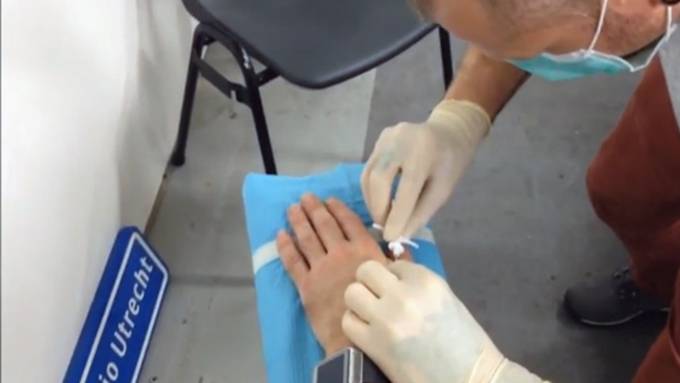Man embeds computer chips in hands to store Bitcoin
Source: telegraph.co.uk

A Dutch entrepreneur has had two wireless computer chips implanted under the skin in his hands to allow him to store digital currencies like Bitcoin inside his body.
Martijn Wismeijer is the founder of Mr Bitcoin, a company which installs and operates crypto-currency cash machines in and around his native Amsterdam and across Europe.
This month he chose to undergo a painful procedure to embed NFC (near-field communication) chips under his skin. These chips can be read by a range of devices including smartphones like the Samsung Galaxy S5 and Apple iPhone 6, and can be adapted for a range of uses.
Wismeijer has already experimented with storing crypto-currencies such as Bitcoin on the chip, but he adds that it is vital to encrypt them to prevent theft – especially if it’s common knowledge that you have a chip and tell people where it can be found.
He had used it to store the private keys for his Bitcoin wallets. In the end he decided that it’s not yet secure enough for him to use permanently, but said that the experiment was a success.
He has also used the chips to program an alarm clock to only switch off when he places one or both of them against a sensor – forcing him to wake up on time in the mornings. He also hopes to fit an NFC-enabled door lock at home so that he can ditch his house keys and instead just touch his palm to the door frame in order to gain access.
The glass chips he had implanted were xNTi devices which come pre-installed in syringes to plunge them into the fatty flesh under the skin. The 2mm by 12mm chips only store 888 bytes, but can transfer that over short distances when in the presence of an NFC reader.
New models with more memory are currently being designed, but these will be larger and more painful to install as they will have to be unfolded under the skin as opposed to just being injected.
“Most doctors will not want to install the implant so a body manipulation artist (preferably not just tattoo artist or piercer) will be your next best bet, but make sure they work according to strict hygiene codes and know what they are doing,” said Wismeijer.
The pain from the injection lasts around a day and then you can start playing with it.
“Don’t be like me: I wanted to try it out even before the blood dried up but it is like a new mobile phone that needs to be fully charged before you switch it on the first time. Really you should leave it alone until it is no longer swollen and healed or you might risk infection and then your body might reject the implant,” said Wismeijer.
“I found that most older people tend to respond with a ’why?’ when I tell them about my implants.”
“The reason I did take the implants is that I have real-world uses for it today, my phones and tablets are all compatible. I personally feel that by supporting these bio-hacking developments we can learn what works and what doesn’t and that some day, in the not so distant future we will be able to implant more functionality like sub dermal glucose sensors or heart rate monitors and other vital health monitoring devices. Imagine a normally invisible tattoo on your arm glowing red when you get a heart attack, swipe your phone and your phone will notify doctor.
“By supporting these bio-hacking initiatives I believe we are paving the way for social acceptance while at the same time we support the bio-hacking technology that drives it.”
Source: telegraph.co.uk






















